Friday, 21 August 2015: The rest of the way from Tallahassee to Lisbon
Written 31 August 2015
After I gave up on sleeping, I happened to look at a screen in the row in front of us and saw—could this be right?—George Clooney and Hugh Laurie, together, in a scifi movie! What the heck was that? I sorted through the choices and figured out it had to be Tomorrowland, which I watched just enough of to confirm my guess (and to note that Laurie had, in fact, reverted to his British accent), then switched over and watched How to Train Your Dragon, which I had just time to finish before we landed.
An hour and a half from landing (at the crack of dawn) in Amsterdam, they served us strawberry yogurt, orange juice that was mostly still frozen, a chilled croisant, jam, and cheddar for breakfast. Again, please stop chilling the croissant!

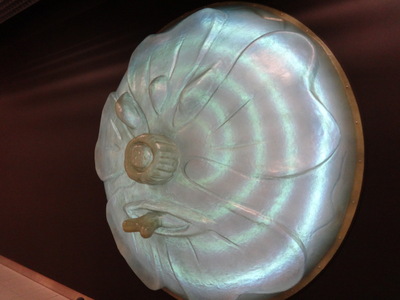 Flight connections in Amsterdam are amazingly easy, quick, and smooth. We went through fast and easy passport control, but no customs, so we didn't have to go through security a second time. We got our third-leg boarding passes and gate info from an automated kiosk and reported to the gate with two hours of our two-and-a-half-hour layover to spare. The coffee shops look at us like we were nuts when we asked for decaf, so we had hot chocolate instead, and David had a bun of some kind, not having eaten his croissant, read our Kindles, browsed the shops, and admired the art, which included these (and other) large glowing glass faces, mounted on the wall. Each was perhaps four feet in diameter
Flight connections in Amsterdam are amazingly easy, quick, and smooth. We went through fast and easy passport control, but no customs, so we didn't have to go through security a second time. We got our third-leg boarding passes and gate info from an automated kiosk and reported to the gate with two hours of our two-and-a-half-hour layover to spare. The coffee shops look at us like we were nuts when we asked for decaf, so we had hot chocolate instead, and David had a bun of some kind, not having eaten his croissant, read our Kindles, browsed the shops, and admired the art, which included these (and other) large glowing glass faces, mounted on the wall. Each was perhaps four feet in diameter
Another object I stopped to inspect may or may not have been art. It was a section of stainless-steel wall that lengthwise for a short distance down the center of the wide corridor near our gate. It was just long enough to accommodate three large metal doors with the usual push-bars for opening, each prominently marked "Emergency Exit Only." But the section of wall, with its three doors, was free-standing, in the middle of the hallway; you could walk all the way around it without impediment. Odd.
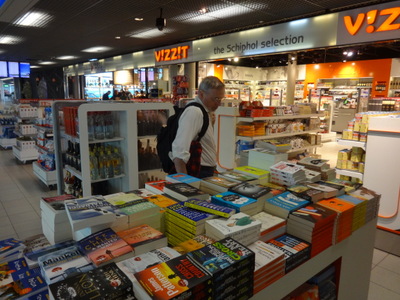
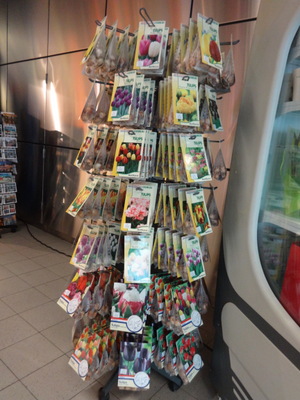 Here, David looks over the large English-language section of a bookstore near the gate, but he found nothing we couldn't live without.
Here, David looks over the large English-language section of a bookstore near the gate, but he found nothing we couldn't live without.
A very common item in all the shops in the airport was tulips. You could buy fresh, cut tulips; potted tulips in bud or bloom; packages of tulip bulbs (shown here at the right) in many, many varieties; and even carved wooden tulips, in bouquets or standing in pots. I didn't read the labels—I wonder how the USDA feels about live tulip bulbs brought in from outside the country.
Our flight to Lisbon took off, and arrived, exactly on time. In Amsterdam, we'd set our watches six hours ahead, but on the flight to Lisbon, we had to set them an hour back, because Portugal is on GMT.

 We collected our luggage promptly (David's still in his Delta gold medallion year, so we get expedited baggage handling), from carrousels decorated with these slightly-larger-than-life-size animals, strolled through the "nothing to declare" lane, and emerged into the airport's mobbed main hall, where our Viking adventure began.
We collected our luggage promptly (David's still in his Delta gold medallion year, so we get expedited baggage handling), from carrousels decorated with these slightly-larger-than-life-size animals, strolled through the "nothing to declare" lane, and emerged into the airport's mobbed main hall, where our Viking adventure began.
A team of three Viking "tour escorts," dressed in bright red shirts and holding the large red "Viking" sign, were waiting in the little corral set aside for such things directly in front of the exit from customs. We spotted them just as they spotted the bright red Viking badges pasted to our shirts (as they had requested). Two stayed to watch for more arrivals, and one directed us down a ramp and around a kiosk to meet her. She collected two other couples who had already arrived, took us out to the curb, and sent us off in a waiting six-passenger van to our hotel, the Tivoli Lisboa (first lesson: the city's name is pronounced "leezh-bo'-uh).
Earlier, when I had Google-mapped the Tivoli out of curiosity, I saw that Lisbon has three Tivolis and that the Tivoli Oriente, a half hour's drive from ours, had a Hippopotamus Grill in it—too bad it was so far away! But when we arrived at the Tivoli Lisboa, imagine my delighted surprise to discover that its restaurant is an actual Brasserie Flo! Even better!
Written 1 September 2015
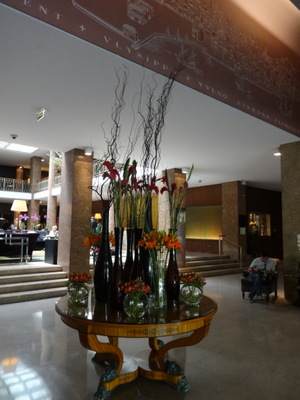 We were ushered past the brasserie into the lovely hotel lobby and to a table set up next to the reception desk that was dealing exclusively with Viking guests. After leaving our luggage (which we never had to handle; once it had a Viking tag on it with our stateroom number, it just followed us around) and being told our rooms would be ready at 2 p.m., we went on to the Viking welcome center, set up in a meeting room off the lobby, to meet our tour director, Miguel, a small energetic local guy with excellent English, the trademark red Viking shirt, and a snazzy flat cap. Over coffee and cookies, we sat down with one of his assistants and then with Miguel himself to talk about what came next.
We were ushered past the brasserie into the lovely hotel lobby and to a table set up next to the reception desk that was dealing exclusively with Viking guests. After leaving our luggage (which we never had to handle; once it had a Viking tag on it with our stateroom number, it just followed us around) and being told our rooms would be ready at 2 p.m., we went on to the Viking welcome center, set up in a meeting room off the lobby, to meet our tour director, Miguel, a small energetic local guy with excellent English, the trademark red Viking shirt, and a snazzy flat cap. Over coffee and cookies, we sat down with one of his assistants and then with Miguel himself to talk about what came next.
We were issued new paper tags to put on our luggage, color coded orange for bus C, our bus assignment for the entire cruise, and some descriptive paperwork. We signed up on the spot for two of the three optional (i.e., not included in our cruise fee) tours. We had planned to sign up for all three, but Miguel advised against the third (a dinner the following night with Fado concert), saying that recent guests had not considered it good value for the money. Coffee and cookies were provided in the welcome center, so we just hung around there for a little while, until it was lunchtime, and made a beeline for the Brasserie Flo.
It was all we'd hoped, though not as elaborately Art Nouveau/Art Deco as many of the ones in France. I also spotted only one token sauerkraut dish on the menu. Alas, they were out of whelks, so the small seafood platter I had planned to order was less appealing, but otherwise it was great.

 We were greeted at the door with the view of this cold seafood platter for two. Behind it, you can see all the bins of oysters, clams, other seafood, and lemons.
We were greeted at the door with the view of this cold seafood platter for two. Behind it, you can see all the bins of oysters, clams, other seafood, and lemons.
At the right here is our amuse-bouche, little toasts with a smooth tuna pâté. Next to the dish is a little package of "beurre d'Isigny," a famous butter from Normandy that we're fond of, to spread on our crusty bread buns. Okay, not very Portuguese, but we're missing our usual trip to France this year, remember.
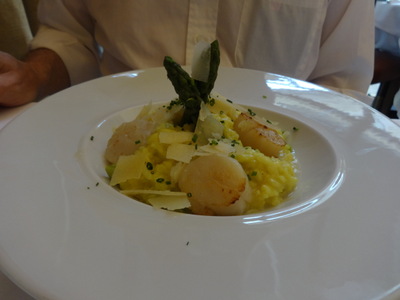
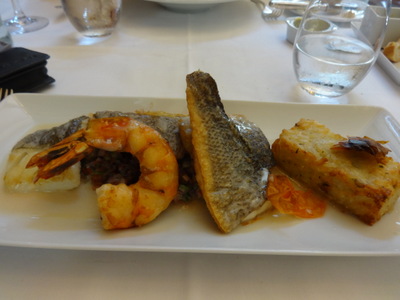 David ordered scallop and asparagus risotto, which he declared the best of his life. The risotto was warmly flavored and colored with saffron and included chunks of excellent asparagus. You can see two entire spears of asparagus crossing above the seared scallops arranged around the sides, and the whole thing was showered with large flakes of Parmesan. The bite I had was terrific.
David ordered scallop and asparagus risotto, which he declared the best of his life. The risotto was warmly flavored and colored with saffron and included chunks of excellent asparagus. You can see two entire spears of asparagus crossing above the seared scallops arranged around the sides, and the whole thing was showered with large flakes of Parmesan. The bite I had was terrific.
Without the inducement of the whelks, I ordered the mixed seared seafood you see at the right, accompanied by a rectangular block of fried risotto laced with tiny cockles and garnished with fried tomato skin. The fish at the left was fresh cod, which was outstanding; then a chunk of excellent salmon, partly hidden by the leaning prawn; then two pieces that I'm pretty sure were "daurado," the gilt-head seabream. Highly satisfactory lunch!

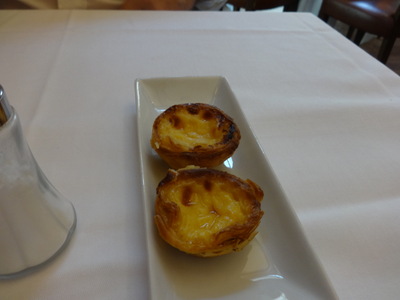 At the left here is the most common brand of bottled water in the Lisbon area—no greasy kid stuff for the Portuguese!
At the left here is the most common brand of bottled water in the Lisbon area—no greasy kid stuff for the Portuguese!
We didn't order dessert, but the mignardises they brought anyway were miniature "pasteis de nata," little cream tarts about 1.25 inches across. The regular ones are more like 3 inches. (Lesson: "pasteis" is pronounced "poss-tay'-eesh"; the singular is "pastel"). We had these in Brazil a few years ago and were looking forward to having more—they are characteristic of Portuguese-speaking areas the world over.
Just as we were returning to the lobby after lunch, Buz and Kathy arrived, in another van-load from the airport, so we repaired once again to the Viking welcome center while they went through their luggage-tag, paperwork, sign-up routine. (we were pleased to be assigned to the same bus. We never did figure out how the assignment was done—not alphabetical, not by stateroom price or location; maybe by order of signing up for the cruise) The rooms still weren't ready, so we lounged in the lobby until they were. Once again, our luggage followed us to our rooms.
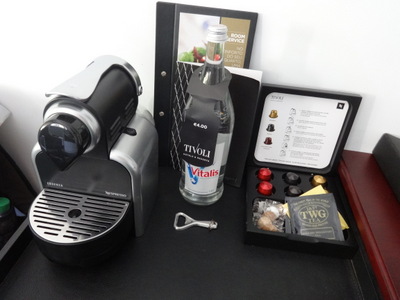
 The hotel rooms themselves were lovely, with especially comfortable beds, electric shutters, and great showers. At the left here is the coffee service supplied by the hotel. The machine works like a Keurig—it has a water reservoir in the back, and the little colored "bonbons" at the right are coffee capsules of different flavors. The gold ones are decaf. In front of the coffees are tea bags and little individually wrapped hemispherical sugar lumps of two colors. In the center are the room-service menus, a 4-euro bottle of water, and a bottle opener. Below the counter is a fully stocked minibar/fridge and a shelf with coffee cups and saucers.
The hotel rooms themselves were lovely, with especially comfortable beds, electric shutters, and great showers. At the left here is the coffee service supplied by the hotel. The machine works like a Keurig—it has a water reservoir in the back, and the little colored "bonbons" at the right are coffee capsules of different flavors. The gold ones are decaf. In front of the coffees are tea bags and little individually wrapped hemispherical sugar lumps of two colors. In the center are the room-service menus, a 4-euro bottle of water, and a bottle opener. Below the counter is a fully stocked minibar/fridge and a shelf with coffee cups and saucers.
Already pretty impressive, but the photo at the right shows the additional tray supplied by Viking, which includes an electric kettle, British tea bags, sugar, capsules of real cream, stirrers, napkins, paper to-go cups with lids as well as large china mugs, and a free bottle of water! Even though the tap water throughout Portugal is palatable and perfectly safe to drink, Viking made a point of keeping us always amply supplied with bottled water, just to encourage proper hydration.

 Once we'd checked in, showered and changed, and done a little unpacking, we met in the lobby to check out the neighborhood.
Once we'd checked in, showered and changed, and done a little unpacking, we met in the lobby to check out the neighborhood.
Here, I (on the left) pose with Kathy and Buz just outside the hotel.
At the right is an especially good shot David got from the van as we drove into town of a monumental statue of Josť de Carvalho de Mello, Count de Oeiras, Marquès de Pombal, commonly called the Marquis of Pombal or just Pombal, with a lion at his side (representing his faithful sidekick England). His name recurred in just about every lecture and tour we had all week; he was prime minister during a crucial period in Portugal's history, and in Lisbon, he is particuarly noted as the one who directed the reconstruction of the city after the catastrophic earthquake of 1755.
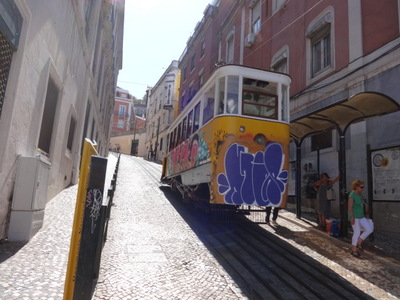
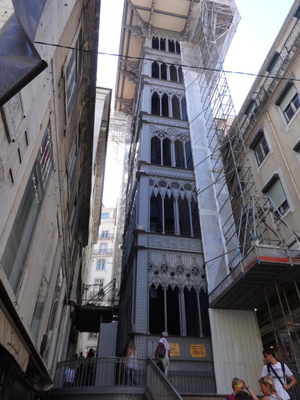 As we strolled from the hotel along Avenida do Republica toward the harbor, the first half trended gently downhill, and the last half was flat. On either side of us, though, the ground sloped steeply uphill.
As we strolled from the hotel along Avenida do Republica toward the harbor, the first half trended gently downhill, and the last half was flat. On either side of us, though, the ground sloped steeply uphill.
In the left-hand photo is a funicular, giving folks a lift up to the higher streets.
At the right is an actual elevator taking them straight up. At the top, a bridge connects to a higher street. It dates from the golden age of iron construction (think Eiffel Tower) and has been declared a national historical monument. We didn't ride it, as the line of tourists and passengers waiting their turns was quite long, and we had quite enough to do and see along the lower street.

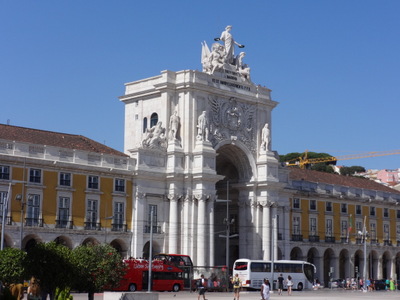 On top of the hill on the other side of the street was the castle, which we never got a chance to learn much more about.
On top of the hill on the other side of the street was the castle, which we never got a chance to learn much more about.
In a large open square near the harbor was the magnificent structure on the right. Kathy and I viewed it from this angle, puzzled over the Latin inscriptions at the top, and hypothesized that it might be the national archives. Later, we learned that it's not a building at all but a triumphal arch. The street you reached by passing under it was very well thought of for its many restaurants. Again, we never got a chance to explore that street very thoroughly.
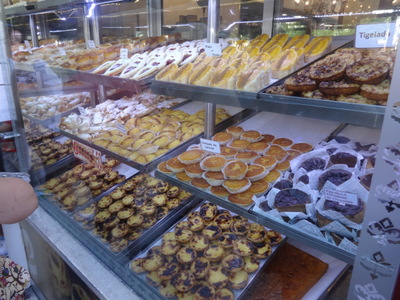
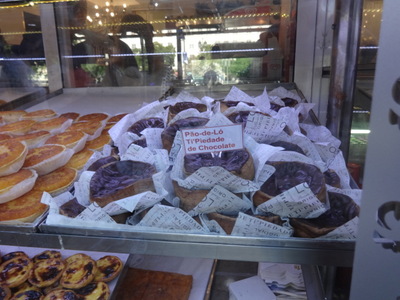 At the left here is a pastry-shop window. (Throughout the trip, I found the glare off windows extremely frustrating; it made photography through glass very hard.) The whole bottom shelf is full-size pasteis de nata. On the other shelves are little orange cheesecakes, plain cheesecakes, slices of cinnamon jelly roll, coconut rolls, and Azores-style custard.
At the left here is a pastry-shop window. (Throughout the trip, I found the glare off windows extremely frustrating; it made photography through glass very hard.) The whole bottom shelf is full-size pasteis de nata. On the other shelves are little orange cheesecakes, plain cheesecakes, slices of cinnamon jelly roll, coconut rolls, and Azores-style custard.
The objects on the middle shelf at the right, which are shown here in the right-hand photo, I take to be little soft cakes with chocolate topping. Perhaps they use up some of the left-over egg whites—pasteis de nata use cream, sugar, and egg yolks, and the vast majority of desserts in Portugal incorporate some form of "egg sweet," which is pure egg yolks and sugar.

 On our way back toward the hotel, we encountered a wine shop that looked interesting and, once we went in, turned out to be amazing! It was called, in several languages, "Wines of Portugal; a world of difference."
On our way back toward the hotel, we encountered a wine shop that looked interesting and, once we went in, turned out to be amazing! It was called, in several languages, "Wines of Portugal; a world of difference."
Just inside the door was this excellent map of the country's wine-growing regions, for the convenience of those tasting the wines. The Lisbon region is tall and narrow and runs along the coast in the middle of the country. The city of Lisbon is at its southern end. The boxes off to the side of the map list the various subregions and varieties.

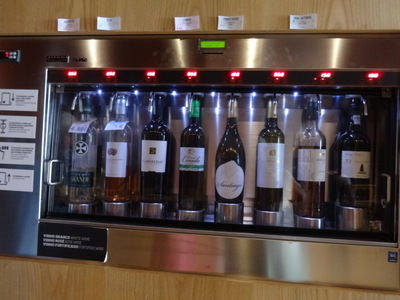 The high walls all the way round the room were covered with wine racks offering hundreds of bottles for sale, and on the left and right walls, at eye level, were dispensers, each offering eight wines for tasting, reds on the left, whites on the right. The center was occupied by long heavy wooden tables with chairs and spit buckets.
The high walls all the way round the room were covered with wine racks offering hundreds of bottles for sale, and on the left and right walls, at eye level, were dispensers, each offering eight wines for tasting, reds on the left, whites on the right. The center was occupied by long heavy wooden tables with chairs and spit buckets.
The idea was that you purchased, from the counter at the back of the room, a tasting card—a card with a chip—on which you put as much money as you wanted, and you were issued a glass. You then addressed yourself to one dispenser or the other, inserted the card into a slot, stuck your glass under the appropriate spout, and pressed the dispenser button to have about 100 ml of wine poured into your glass.
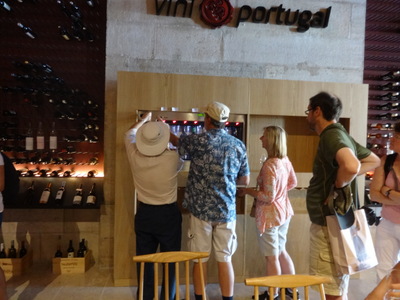
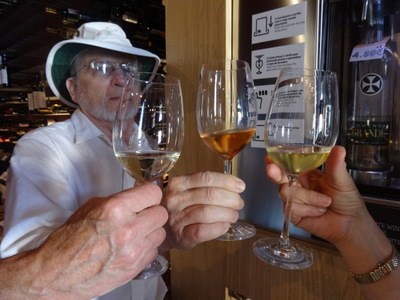 David, Buz, and Kathy chipped in for a card with 9 euros on it and tackled the first dispenser. The prices posted above the bottles in the dispenser ranged from 0.50 to 1.5 euros, and the card reader told you how much money was left on your card before and after a taste was dispensed.
David, Buz, and Kathy chipped in for a card with 9 euros on it and tackled the first dispenser. The prices posted above the bottles in the dispenser ranged from 0.50 to 1.5 euros, and the card reader told you how much money was left on your card before and after a taste was dispensed.
At the right are the three whites they tried first, very different in color and (I'm told) in flavor. While sipping, they could study the map to figure out where the wine came from. They tasted and sipped their way through wines of both colors, until David finished out the card, which was down to 0.50 euro, by having another euro added to it so that he could sample a big red he hadn't tried yet.
Very slick system! The place also included a tiny book store with a selection of wine books. The only criticism I heard from the other three was that some of the wines would have been much better with food and that even a basket of bread tidbits for clearing the palate would have been a good addition. All three felt they got a good basic feel for the range of Portuguese wines and began to form regional preferences.
At 7 p.m., we reported to the hotel mezzanine for the official Viking welcome briefing, during which small glasses of white port were distributed. At that point, we learned what times to show up for the morning's bus and walking tour of Lisbon and the optional afternoon tile-factory tour (for which we had signed up) in the afternoon, as well as what to expect the day after, when we would be taken by bus to Porto to meet the ship. Viking keeps its briefings short and to the point, so it only took a few minutes.
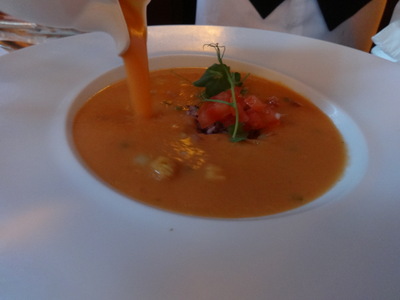
 For dinner, we talked Buz and Kathy into Brasserie Flo, where we wanted to go again. David got the menu of the evening, which started with gazpacho. The plate arrived with a little pyramid of chopped veggies and a pea sprout in the middle, and the liquid part of the soup was poured on at the table. For a man who hates cucumber, he's surprisingly fond of gazpacho.
For dinner, we talked Buz and Kathy into Brasserie Flo, where we wanted to go again. David got the menu of the evening, which started with gazpacho. The plate arrived with a little pyramid of chopped veggies and a pea sprout in the middle, and the liquid part of the soup was poured on at the table. For a man who hates cucumber, he's surprisingly fond of gazpacho.
I started with a platter of four of these lovely and extremely delicious oysters. They were served, as usual, with little slices of pumpernickel and a particularly fierce mignonette sauce, but as usual, I stuck with lemon and pepper. We shared the pumpernickel around between courses, but after a couple of experimental tastes, the mignonette went back to the kitchen.
Meanwhile Buz and Kathy split a serving of foie gras with fig jam and brioche toast.

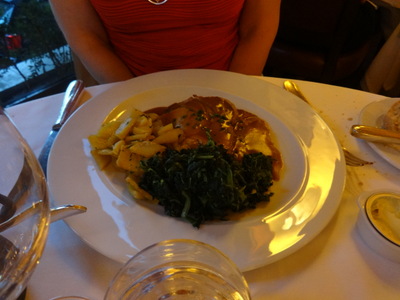 For his main course, Buz had the same mixed grilled seafood I had for lunch and enjoyed it just as much. At dinner, it came with a big dish of ratatouille. David had salmon, which came on a bed of the tiny chive-filled ravioli that I think of as a specialty of Lyon. Under the ravioli was another risotto.
For his main course, Buz had the same mixed grilled seafood I had for lunch and enjoyed it just as much. At dinner, it came with a big dish of ratatouille. David had salmon, which came on a bed of the tiny chive-filled ravioli that I think of as a specialty of Lyon. Under the ravioli was another risotto.
Kathy ordered the roast pork, as she does at every opportunity. This one came smothered in brown gravy and sprinkled with fresh chives. On the side, fried squares of potato and finely shredded and sautéed mild-flavored mustard greens.
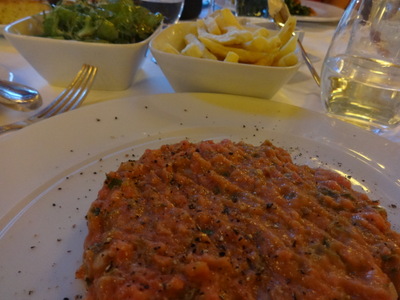
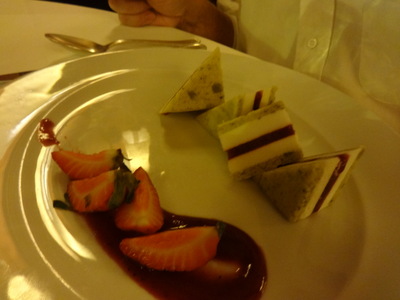 I ordered beef tartare, which was excellent—much better than you sometimes get in France with too much sour pickle chopped up in it. This one was perfectly seasoned with salt and pepper, herbs, egg yolk, and, as I specified when asked, just a little tabasco. On the side I got the traditional fries and salad.
I ordered beef tartare, which was excellent—much better than you sometimes get in France with too much sour pickle chopped up in it. This one was perfectly seasoned with salt and pepper, herbs, egg yolk, and, as I specified when asked, just a little tabasco. On the side I got the traditional fries and salad.
The dessert that came with David's menu was called a "club sandwich" of raspberry and pistachio—layers of cake, cream, and fruit paste cut into neat triangles and garnished with chocolate and strawberries.
Buz and Kathy made do with the pasteis de nata that came as mignardises.
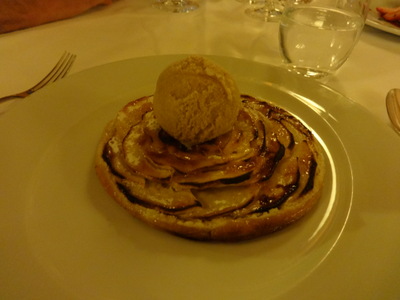

I ordered apple tart and got this beautiful little individually baked confection of puff pastry, custard cream, apples, and on top a ball of cinnamon ice cream. We love Brasserie Flos.
After dinner, Buz, Kathy, and I went up to the rooftop bar just for the view. We didn't stay long, as it was cold and windy up there, but I got this shot of the castle before we left. The Portuguese seem to be almost as good as the French at lighting buildings at night.
Previous entry
List of Entries
Next entry

 Flight connections in Amsterdam are amazingly easy, quick, and smooth. We went through fast and easy passport control, but no customs, so we didn't have to go through security a second time. We got our third-leg boarding passes and gate info from an automated kiosk and reported to the gate with two hours of our two-and-a-half-hour layover to spare. The coffee shops look at us like we were nuts when we asked for decaf, so we had hot chocolate instead, and David had a bun of some kind, not having eaten his croissant, read our Kindles, browsed the shops, and admired the art, which included these (and other) large glowing glass faces, mounted on the wall. Each was perhaps four feet in diameter
Flight connections in Amsterdam are amazingly easy, quick, and smooth. We went through fast and easy passport control, but no customs, so we didn't have to go through security a second time. We got our third-leg boarding passes and gate info from an automated kiosk and reported to the gate with two hours of our two-and-a-half-hour layover to spare. The coffee shops look at us like we were nuts when we asked for decaf, so we had hot chocolate instead, and David had a bun of some kind, not having eaten his croissant, read our Kindles, browsed the shops, and admired the art, which included these (and other) large glowing glass faces, mounted on the wall. Each was perhaps four feet in diameter
 Here, David looks over the large English-language section of a bookstore near the gate, but he found nothing we couldn't live without.
Here, David looks over the large English-language section of a bookstore near the gate, but he found nothing we couldn't live without.
 We collected our luggage promptly (David's still in his Delta gold medallion year, so we get expedited baggage handling), from carrousels decorated with these slightly-larger-than-life-size animals, strolled through the "nothing to declare" lane, and emerged into the airport's mobbed main hall, where our Viking adventure began.
We collected our luggage promptly (David's still in his Delta gold medallion year, so we get expedited baggage handling), from carrousels decorated with these slightly-larger-than-life-size animals, strolled through the "nothing to declare" lane, and emerged into the airport's mobbed main hall, where our Viking adventure began. We were ushered past the brasserie into the lovely hotel lobby and to a table set up next to the reception desk that was dealing exclusively with Viking guests. After leaving our luggage (which we never had to handle; once it had a Viking tag on it with our stateroom number, it just followed us around) and being told our rooms would be ready at 2 p.m., we went on to the Viking welcome center, set up in a meeting room off the lobby, to meet our tour director, Miguel, a small energetic local guy with excellent English, the trademark red Viking shirt, and a snazzy flat cap. Over coffee and cookies, we sat down with one of his assistants and then with Miguel himself to talk about what came next.
We were ushered past the brasserie into the lovely hotel lobby and to a table set up next to the reception desk that was dealing exclusively with Viking guests. After leaving our luggage (which we never had to handle; once it had a Viking tag on it with our stateroom number, it just followed us around) and being told our rooms would be ready at 2 p.m., we went on to the Viking welcome center, set up in a meeting room off the lobby, to meet our tour director, Miguel, a small energetic local guy with excellent English, the trademark red Viking shirt, and a snazzy flat cap. Over coffee and cookies, we sat down with one of his assistants and then with Miguel himself to talk about what came next. 
 We were greeted at the door with the view of this cold seafood platter for two. Behind it, you can see all the bins of oysters, clams, other seafood, and lemons.
We were greeted at the door with the view of this cold seafood platter for two. Behind it, you can see all the bins of oysters, clams, other seafood, and lemons.
 David ordered scallop and asparagus risotto, which he declared the best of his life. The risotto was warmly flavored and colored with saffron and included chunks of excellent asparagus. You can see two entire spears of asparagus crossing above the seared scallops arranged around the sides, and the whole thing was showered with large flakes of Parmesan. The bite I had was terrific.
David ordered scallop and asparagus risotto, which he declared the best of his life. The risotto was warmly flavored and colored with saffron and included chunks of excellent asparagus. You can see two entire spears of asparagus crossing above the seared scallops arranged around the sides, and the whole thing was showered with large flakes of Parmesan. The bite I had was terrific.
 At the left here is the most common brand of bottled water in the Lisbon area—no greasy kid stuff for the Portuguese!
At the left here is the most common brand of bottled water in the Lisbon area—no greasy kid stuff for the Portuguese!

 The hotel rooms themselves were lovely, with especially comfortable beds, electric shutters, and great showers. At the left here is the coffee service supplied by the hotel. The machine works like a Keurig—it has a water reservoir in the back, and the little colored "bonbons" at the right are coffee capsules of different flavors. The gold ones are decaf. In front of the coffees are tea bags and little individually wrapped hemispherical sugar lumps of two colors. In the center are the room-service menus, a 4-euro bottle of water, and a bottle opener. Below the counter is a fully stocked minibar/fridge and a shelf with coffee cups and saucers.
The hotel rooms themselves were lovely, with especially comfortable beds, electric shutters, and great showers. At the left here is the coffee service supplied by the hotel. The machine works like a Keurig—it has a water reservoir in the back, and the little colored "bonbons" at the right are coffee capsules of different flavors. The gold ones are decaf. In front of the coffees are tea bags and little individually wrapped hemispherical sugar lumps of two colors. In the center are the room-service menus, a 4-euro bottle of water, and a bottle opener. Below the counter is a fully stocked minibar/fridge and a shelf with coffee cups and saucers.
 As we strolled from the hotel along Avenida do Republica toward the harbor, the first half trended gently downhill, and the last half was flat. On either side of us, though, the ground sloped steeply uphill.
As we strolled from the hotel along Avenida do Republica toward the harbor, the first half trended gently downhill, and the last half was flat. On either side of us, though, the ground sloped steeply uphill. 
 On top of the hill on the other side of the street was the castle, which we never got a chance to learn much more about.
On top of the hill on the other side of the street was the castle, which we never got a chance to learn much more about.
 At the left here is a pastry-shop window. (Throughout the trip, I found the glare off windows extremely frustrating; it made photography through glass very hard.) The whole bottom shelf is full-size pasteis de nata. On the other shelves are little orange cheesecakes, plain cheesecakes, slices of cinnamon jelly roll, coconut rolls, and Azores-style custard.
At the left here is a pastry-shop window. (Throughout the trip, I found the glare off windows extremely frustrating; it made photography through glass very hard.) The whole bottom shelf is full-size pasteis de nata. On the other shelves are little orange cheesecakes, plain cheesecakes, slices of cinnamon jelly roll, coconut rolls, and Azores-style custard.

 The high walls all the way round the room were covered with wine racks offering hundreds of bottles for sale, and on the left and right walls, at eye level, were dispensers, each offering eight wines for tasting, reds on the left, whites on the right. The center was occupied by long heavy wooden tables with chairs and spit buckets.
The high walls all the way round the room were covered with wine racks offering hundreds of bottles for sale, and on the left and right walls, at eye level, were dispensers, each offering eight wines for tasting, reds on the left, whites on the right. The center was occupied by long heavy wooden tables with chairs and spit buckets.
 David, Buz, and Kathy chipped in for a card with 9 euros on it and tackled the first dispenser. The prices posted above the bottles in the dispenser ranged from 0.50 to 1.5 euros, and the card reader told you how much money was left on your card before and after a taste was dispensed.
David, Buz, and Kathy chipped in for a card with 9 euros on it and tackled the first dispenser. The prices posted above the bottles in the dispenser ranged from 0.50 to 1.5 euros, and the card reader told you how much money was left on your card before and after a taste was dispensed.
 For dinner, we talked Buz and Kathy into Brasserie Flo, where we wanted to go again. David got the menu of the evening, which started with gazpacho. The plate arrived with a little pyramid of chopped veggies and a pea sprout in the middle, and the liquid part of the soup was poured on at the table. For a man who hates cucumber, he's surprisingly fond of gazpacho.
For dinner, we talked Buz and Kathy into Brasserie Flo, where we wanted to go again. David got the menu of the evening, which started with gazpacho. The plate arrived with a little pyramid of chopped veggies and a pea sprout in the middle, and the liquid part of the soup was poured on at the table. For a man who hates cucumber, he's surprisingly fond of gazpacho.
 For his main course, Buz had the same mixed grilled seafood I had for lunch and enjoyed it just as much. At dinner, it came with a big dish of ratatouille. David had salmon, which came on a bed of the tiny chive-filled ravioli that I think of as a specialty of Lyon. Under the ravioli was another risotto.
For his main course, Buz had the same mixed grilled seafood I had for lunch and enjoyed it just as much. At dinner, it came with a big dish of ratatouille. David had salmon, which came on a bed of the tiny chive-filled ravioli that I think of as a specialty of Lyon. Under the ravioli was another risotto.
 I ordered beef tartare, which was excellent—much better than you sometimes get in France with too much sour pickle chopped up in it. This one was perfectly seasoned with salt and pepper, herbs, egg yolk, and, as I specified when asked, just a little tabasco. On the side I got the traditional fries and salad.
I ordered beef tartare, which was excellent—much better than you sometimes get in France with too much sour pickle chopped up in it. This one was perfectly seasoned with salt and pepper, herbs, egg yolk, and, as I specified when asked, just a little tabasco. On the side I got the traditional fries and salad.
